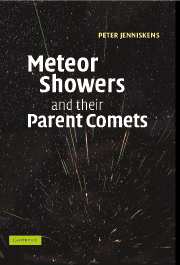Book contents
- Frontmatter
- Dedication
- Contents
- Preface
- Acknowledgements
- Part I Introduction
- Part II Parent bodies
- Part III Young streams from water vapor drag
- Part IV Young streams from comet fragmentation
- 20 Quadrantids
- 21 Broken comets
- 22 Geminids
- 23 The sunskirting Arietids and δ-Aquariids
- 24 α-Capricornids and κ-Cygnids
- 25 The Taurid complex
- Part V Old streams and sporadic meteoroids
- Part VI Impact and relevance of meteor showers
- Appendix
- Tables
- Index
- Units and constants
20 - Quadrantids
from Part IV - Young streams from comet fragmentation
Published online by Cambridge University Press: 05 July 2015
- Frontmatter
- Dedication
- Contents
- Preface
- Acknowledgements
- Part I Introduction
- Part II Parent bodies
- Part III Young streams from water vapor drag
- Part IV Young streams from comet fragmentation
- 20 Quadrantids
- 21 Broken comets
- 22 Geminids
- 23 The sunskirting Arietids and δ-Aquariids
- 24 α-Capricornids and κ-Cygnids
- 25 The Taurid complex
- Part V Old streams and sporadic meteoroids
- Part VI Impact and relevance of meteor showers
- Appendix
- Tables
- Index
- Units and constants
Summary
The mystery of the Quadrantid shower (Fig. 20.1) has always been its source. The Quadrantids have a peak ZHR ∼ 130/h, which is the highest of all known annual showers. Unfortunately, the shower is only 8.5 h FWHM wide, and very difficult to observe because of frequent bad weather in early January and a radiant that is in under-culmination at midnight.
Even after the shower was first recognized in January of 1835 (Chapter 1), it took an 1862 report from a lady in Connecticut, stating that she had observed an unusually large number of shooting stars early in the morning of January 2, to first get Edward C. Herrick and then other observers excited. Among those was Alexander S. Hershell, who in 1864 gave the “Shooting Stars of January” their modern name, finding a radiant point at “c Quadrantis Muralis” in the now defunct constellation Quadrans Muralis. In the non-English speaking world, the shower is better known by the name of Bootids. In a modern star atlas, the radiant is at the corner of the constellations Bootes, Hercules and Draco.
The search for its parent first took a clue from the dramatic and rapid evolution of the orbit, discovered in the early modeling by Salah E. Hamid and Mary N. Youssef. This 1963 study added the effect of all planetary perturbations on test particles, six in total, over many orbits. Results were confirmed later by others using more modern computering tools. They found that the orbit had rotated in a nutation cycle from a low inclination of i ∼ 13° and low perihelion distance q ∼ 0.1 AU some 1500 years ago, to its current high i ∼ 72° and q ∼ 0.78 AU (Fig. 20.2). The orbit will continue to evolve to a peak value of i ∼ 76° and q ∼ 1.0 AU about 1000 years from now, before decreasing again.
- Type
- Chapter
- Information
- Meteor Showers and their Parent Comets , pp. 357 - 376Publisher: Cambridge University PressPrint publication year: 2006
- 1
- Cited by



